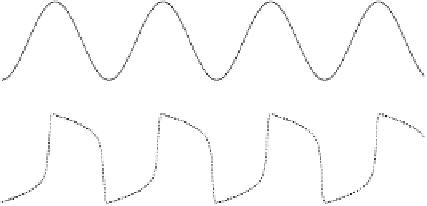Biomedical Engineering Reference
In-Depth Information
0.0
time (s)
0.9
Fig. 4.2.
Linear and nonlinear oscillations. (
Top
) time trace of a linear, or har-
monic, oscillator such as the one displayed in Fig. 4.1. In terms of the discussion in
Chap. 1, this is a simple oscillation. (
Bottom
) time trace of a nonlinear oscillator.
The oscillator is a mass subjected to both linear and nonlinear forces. The linear
forces are restitution, dissipation and energy supply, and the nonlinear force is a
nonlinear dissipation mimicking collisions of the oscillating mass with the wall that
it is attached to. This complex oscillation can be decomposed into its harmonic
constituents, or components, by means of the representation discussed in Chap. 1
harmonic oscillations. In the bottom part of the figure, we show the time evo-
lution of the body's position when it is subjected to all the forces discussed so
far. We have included the linear restitution, the linear dissipation, the exter-
nal force proportional to the velocity that overcomes the linear dissipation,
and the nonlinear dissipation [Arnold et al. 1999], as in (4.5). The nonlinear
dissipation is negligible for small values of the departure from equilibrium
but large for large departures, which takes account of the collisions of the
body with the walls. It is interesting to notice that owing to these collisions,
the signal is no longer harmonic. In terms of our discussion in Chap. 1, it is
a signal which has several
harmonic components
: it can be thought of as a
superposition of several harmonic signals with frequencies that are multiples
of a fundamental frequency.
Beyond observation of numerical simulations of the model, we can qual-
itatively explain the shape of these oscillations. In order to do so, we shall
study a dynamical system whose solutions are easy to understand
geometri-
cally
. Then, we shall show how to map our original problem onto this simpler
one.
Let us therefore study the following
auxiliary
dynamical system:
1
3
cu
3
+(
β
u
=
v
−
−
b
)
u,
(4.6)
v
=
−
ku .
(4.7)


